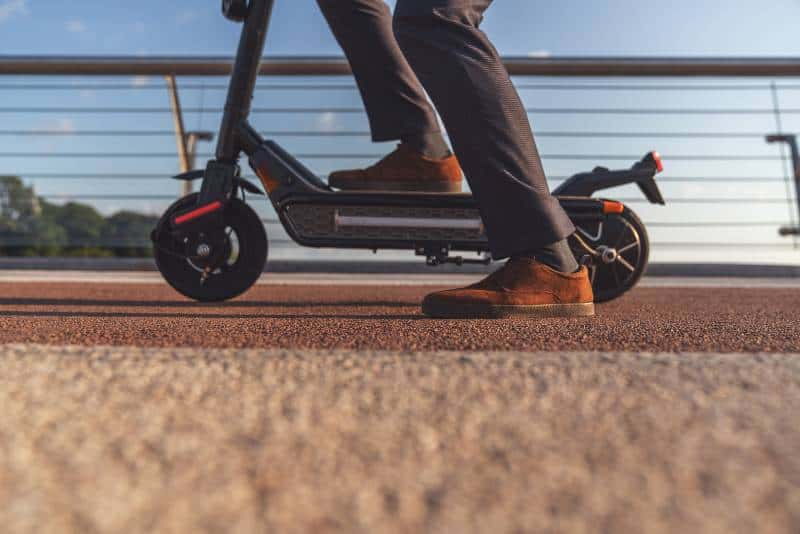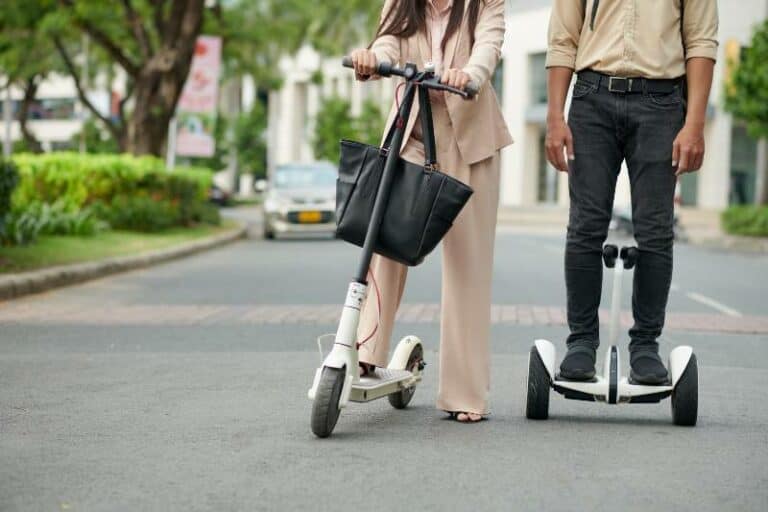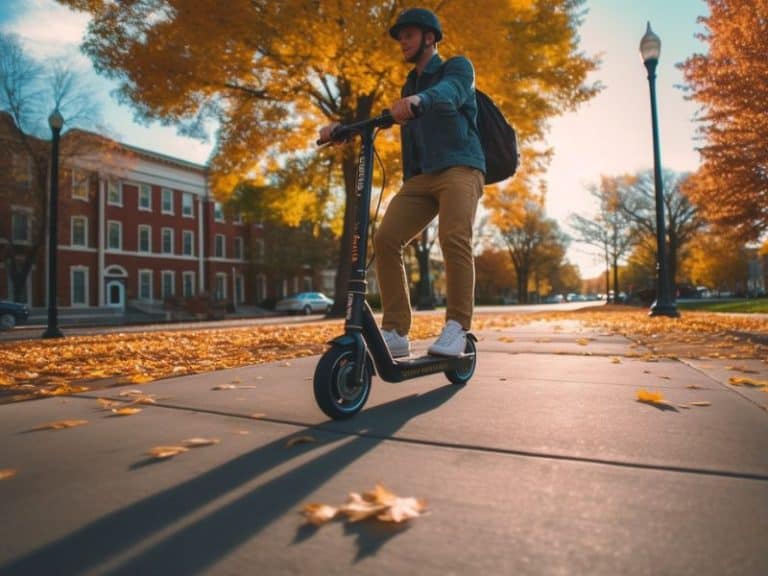The Truth About E-Scooters – Are They Really Eco Friendly?
Electric scooters, or e-scooters, have been all the rage lately. They seem like the perfect solution to our pollution problem – a way for us to get around without harming the environment. But is this really true? Are electric scooters eco-friendly as we think they are? Let’s take a closer look at this new transportation trend and find out!
E-scooters are environmentally friendly because they don’t pollute the air during a ride. Their rechargeable batteries mean zero greenhouse gas emissions when compared to other modes of transportation.
Key Takeaways
- Electric scooters clearly offer an eco-friendly alternative to cars and motorcycles when it comes to short trips, but they are not a perfect solution.
- Before buying one, you should consider the lifecycle of the product (manufacturing and use) as well as its material burden. You should also determine if your electricity is coming from renewable sources as this is necessary to reduce its environmental impact.
- Electric scooters are a new product with the potential to make our lives easier, but the full ecological impacts of the product are still being determined.

Environmental Goals Of Electric Scooters
1. Reducing emissions
Electric scooters can help you reduce emissions by providing you with a more efficient form of transportation. When you ride an electric scooter, you’re not just saving money on gas—you’re also decreasing the amount of carbon dioxide released into the atmosphere by your vehicle.
2. Using technology to save energy
Electric scooters are a way to reduce the use of fossil fuels and other types of fuel while at the same time reducing emissions, contributing to the overall health of our planet. Electric scooters are also known as electric mobility devices, which means they are powered by electricity rather than internal combustion engines.
3. Improving the environment
The ability of electric scooters to reduce emissions and pollution is one of the most compelling reasons to support their use. By reducing the number of cars on the road, electric scooters can help reduce carbon emissions and improve air quality in cities where they’re used.
4. Fewer miles for every car each day
One of the biggest ways that electric scooters can help the environment is by reducing the number of miles driven by cars each day. The United States, with only 5 percent of the world’s population, uses 30 percent of its energy and produces 28 percent more carbon emissions than any other country. Electric scooters can be used in place of cars and public transportation to reduce the number of miles driven by cars. By doing so, we’ll be able to mitigate our impact on climate change and help fight against global warming.
How Eco-Friendly are Electric Scooters
What are electric scooters made of?
Many electric scooter frames are made of aluminum alloy typically used in aerospace or industrial settings, but some companies use carbon fiber instead. Others utilize a combination of the two materials. Their motors consist mostly of metals plus copper wires and magnets, while their batteries contain various metallic elements
What are the materials used in other parts of the scooter?
We must analyze the four main phases of an electric scooter’s life cycle—manufacturing, use, end-of-life, and recycling—to measure its environmental impact as we would with all means of transport.
The first two phases are the manufacturing of the vehicle (where the engine and other components are assembled) and the production phase of energy for powering the vehicle. The latter is determined by how polluting the energy source is.
The vehicle goes through different phases during its lifespans, such as the use phase (when it is driven), the maintenance phase, and the end-of-life phase (when it is recycled or destroyed). Each phase has different environmental impacts
How were the scooters manufactured?
The manufacturing process of electric scooters is similar to that of electric vehicles. We must consider the amount of energy used to extract raw materials, transform them, and assemble them into a final product.
The battery is a crucial, but very polluting part of electronic devices. The production of energy for electric scooters shares similar problems to those of electric cars.
The environmental impact of the electricity production process is lower if renewable or decarbonated energy sources are used. If fossil fuels such as coal, oil, or gas are burned instead, greenhouse gases will be released into the atmosphere.
Charging and replacing batteries
Furthermore, recycling is critical because electric scooters are assembled with scarce materials that can pollute the environment.
If you want to keep your batteries away from environmental pollution, it is key that you properly maintain them.
How do I maintain my electric scooter? Proper maintenance is essential for keeping your e-scooter in good condition for years of use. Read about it here!
Emissions from e-scooters
Because electric scooters are powered by electricity, they do not produce any exhaust fumes. This means you can ride them without contributing to air pollution—the energy that powers your e-scooter is more carbon neutral than petrol or diesel.
Electric Scooters: Full Ecological Impacts Still to be determined
Is the electricity powering my scooter completely green energy?
The benefits of using electricity as fuel—over petrol or diesel—are clear: it’s better for the planet. But what about the sustainability of your supply? As concerns over climate change grow, renewable energy sources like wind and solar are becoming increasingly important forms of electricity generation.
Wind and solar energy are generated by natural, sustainable sources—wind and the sun—and avoid many of the pitfalls that come with other forms of power.
However, one must also consider the costs of obtaining and transporting the raw materials used to make these generators.
Mining coal for power plants is obviously bad for the environment, but so are mining operations that extract neodymium and other rare earth minerals necessary for the construction of wind turbine generators.
It depends on what they’re replacing
Electric scooters are a new product with the potential to make our lives easier, but the full ecological impacts of the product are still being determined.
Electric scooters are currently replacing traditional bicycles as the preferred mode of transportation for many people who live in urban areas. However, their effects on the environment have not yet been fully analyzed.
The lifecycle of electric scooters is similar to that of other consumer products: they are manufactured using raw materials and energy, and then they are used by consumers before being discarded or recycled (or sent to landfills).
The material burden of electric scooters has not yet been calculated; however, it will likely be significant because they require batteries and motors that contain heavy metals and other substances that may be hazardous if released into the environment.
Product Lifetimes and Material Burdens
The researchers discovered that to decrease the scooter’s environmental carbon footprint, we need to make them last longer. If a scooter is used for two years, it emits 141 g of CO2 per km per passenger; though this number is still double what an electric car emits.
However, according to the first available data, currently, electric scooters in real-world conditions have a lifespan of less than one month. In Kentucky, realities are often broken, thrown into rivers, or poorly maintained – making them last for only a short amount of time.
On-demand mobility is gradually becoming more popular, which means that it’s now more important than ever to make sure electric scooters are utilized properly. This will not only help them last longer but also make them a more environmentally friendly option overall.
In most situations, using an electric scooter does not replace a dirtier mode of transportation. It’s unlikely that those who usually commute by car would get rid of their vehicles and rely on electric scooters instead: there are already more environmentally friendly ways to travel long distances, like public transport or biking.
Electric scooters are often seen as a more ecological option than modes of transport such as cycling or walking. Although electric scooters emit more CO2 than other modes of transport, they have become increasingly popular and today make up a significant part of the global mobility sector.
Collection and Redistribution
The collection and redistribution of electric scooters is also an important factor in determining their full ecological impact. While it may seem like a simple process, collecting and redistributing electric scooters can be difficult—and costly—to manage.
In cities where e-scooter sharing programs are popular, the companies that operate them must collect and redistribute the scooters on a regular basis. This process requires specialized vehicles, people to operate them, and other logistical considerations that can add up quickly in terms of time and resources.
Finding the balance
Should I Buy an Electric Scooter?
Electric scooters clearly offer an eco-friendly alternative to cars and motorcycles when it comes to short trips, but they are not a perfect solution. Before buying one, you should consider the lifecycle of the product (manufacturing and use) as well as its material burden. You should also determine if your electricity is coming from renewable sources as this is necessary to reduce its environmental impact.
Are Electric Scooters Eco-Friendly FAQs
Should you have your own e-scooter or rent it?
In the short term, renting an electric scooter is cheaper than buying one. But in the long run it’s a better investment to buy your own. Renting allows you to see more of a city and gives you freedom when traveling as opposed to being stuck with public transportation
What is the Lifespan of an E-Scooter?
Electric scooters tend to have a lifespan of three to five years, though some models are built for longer. To make sure yours lasts as long as possible, keep it clean and well-maintained—especially the battery!
Are scooters better for the environment than cars?
Yes, electric scooters are generally better for the environment than cars. They produce no pollutants and use much less energy than cars. Furthermore, they don’t require as much space to move around in, so they can help reduce traffic congestion and air pollution in cities. Ultimately, it’s up to you to decide whether an electric scooter is right for you. Consider the environmental impact, benefits, and drawbacks of owning one before making your choice. With the right knowledge and preparation, you can make an informed decision that’s best for both yourself and the planet.
Do e-scooters produce CO2?
A study in Paris found that, on average, e-scooters emit six times more carbon dioxide per kilometer than the metro—even though they produce three times less CO2 than cars.
Can electric scooters be recycled?
Each of these components can be recycled in a different way. By handling them separately, every part of an e-scooter can be reused—even its plastic trim and motors.
Conclusion
Electric scooters are a relatively new form of transportation, and their environmental impact is still being studied. While they may not be perfect, they can certainly help reduce our dependence on cars and public transport while providing us with a convenient way to get around town. With the right care and maintenance, electric scooters can provide clean, efficient transportation for years to come. Ultimately, the decision to buy one must be made on a case-by-case basis – considering both environmental and economic factors.
With this information in mind, you can make an informed decision that’s best for both yourself and the planet.






